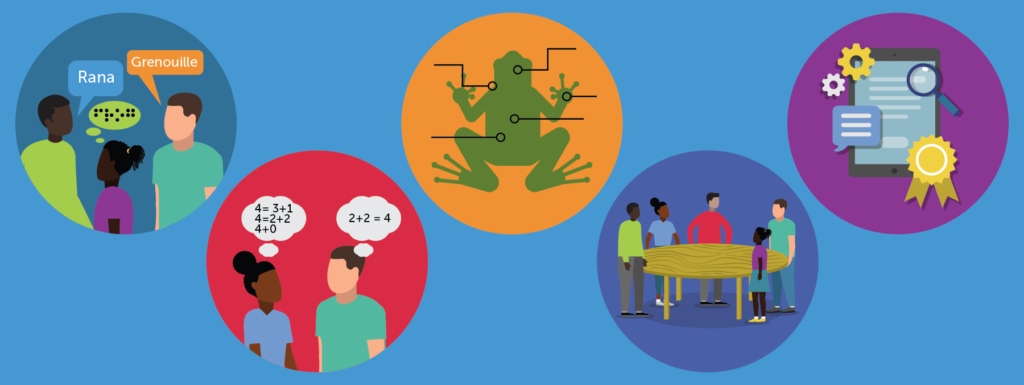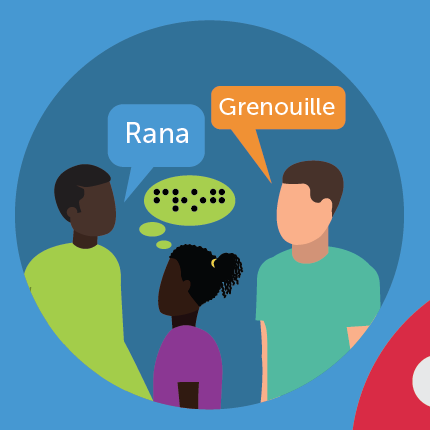This post was originally published on the Digital Promise website.

By Pati Ruiz and Judi Fusco
The learning sciences study the design and implementation of effective learning environments by drawing on a variety of perspectives across a range of physical, social, and technological spaces1. Learning sciences focuses on human learning and helps individuals achieve their fullest potential and attain 21st-century skills. Because of this focus, the learning sciences should be foundational in the design and development of emerging technologies for teaching and learning. AI systems are an emerging technology that are starting to play a significant role in the redesign of learning environments. To increase our chances of creating successful AI systems for learning, they should be grounded in the learning sciences. We’ll discuss five big ideas from the learning sciences in relation to the design of AI systems: Representation and Supports; Collaboration; How Students Think; Building on Students’ Cultural and Linguistic Assets; Assessment and Feedback. We propose that these big ideas are important as a starting point in the design of better AI systems.
Big Idea 1: Representation and Supports
The learning sciences have found that enabling students to make connections across multiple representations (for example, graphs, writing, images, maps, blocks, etc.) contributes to knowledge construction. Different forms of representation give them a way to make sense of concepts in the best way that helps them construct their knowledge. How can this big idea be used in designing an AI system?
In a classroom where a teacher is fielding questions from students about a specific species of frog, an AI system can support the teacher by quickly searching for and projecting a set of visual representations of the frog that are appropriate for the students and have high-quality information for the teacher and students. When teaching about a metabolic function, an animation might help, and the AI system could share the animation and also point to text or other representations that may help students make connections to understand the process. By giving students and teachers just-in-time support like a relevant animation or engaging follow-up questions, AI systems can support teachers to orchestrate learning experiences by automating tasks (as described above) so teachers can spend more time focused on students. Beyond those types of just-in-time supports, AI systems can further support the engagement of all students in sustained creative work—something that has been a challenging problem in the design of learning environments.
Big Idea 2: Collaboration
The learning sciences have found that learning environments should be designed to foster collaboration and help learners work together to share and make sense of challenging problems. Research points us toward more social and collaborative learning environments.
AI systems could support this big idea by making recommendations for how teachers group students or by giving students themselves prompts that may lead to shared understanding when working in groups without the teacher. Emerging AI technologies might help teachers ask different groups the right guiding questions as the AI system “listens” to what each group is discussing. An AI system that asks questions might also be able to assess the answers to those questions, help students arrive at the same conceptual understanding, and determine when the group is ready for a new task.
Big Idea 3: How Students Think
The learning sciences have found that learning environments should be not only collaborative, but also foster adaptive or personalized learning because there is not a single way to learn and individuals have unique needs when it comes to learning environment designs.
AI systems might support teachers in facilitating this big idea by finding instances of student reasoning for teachers to review based on the analysis of video, audio, or student work. AI systems can also quickly provide insights to teachers about what learning path a student is taking and analytics could help teachers understand how each of their students tends to learn a concept based on their writing, speaking, or movements. A teacher might take the feedback given by an AI system and follow-up with students about their individual learning process and make decisions with them about what to do next. By helping students keep track of how they are practicing and providing scaffolds when they are needed and removing them when a student is ready, an AI system can support students’ unique learning needs.
Big Idea 4: Building on Students’ Cultural and Linguistic Assets
The learning sciences have found that learning and teaching are cultural processes and that we best support learning when we include students’ cultural and linguistic backgrounds as pedagogical assets. This big idea means that AI systems need to support learning environments that enable teachers and learners to address the multiple elements of learning, including identity and culture. To do this, developers need to restructure the assumptions that are made about learners and what they know by keeping both teachers and learners in the loop. For example, AI systems can help personalize the materials for Spanish-speaking students and their parents by translating sections of text, or by providing just-in-time translations so that they can more fully participate in learning experiences. Another personalization could be an AI system where the agent speaks to students and engages them using speech patterns similar to those of the student.
Big Idea 5: Assessment and Feedback
There’s been a lot of discussion around how AI systems can support teachers and students with new types of assessment, such as more stealth assessment, or formative assessment. Formative assessment provides specific information to a teacher about students’ strengths and challenges to help a teacher adapt their instruction to meet students’ needs. Students’ needs vary and they can also be challenging to anticipate—this is where AI systems can support teachers and readers. We won’t get into assessment and feedback more here, but check out this Educator CIRCLS webinar on Assessment or read this post on AI and Formative Assessment to learn more about this big idea.
Looking ahead
These big ideas from the learning sciences should be incorporated into AI systems to create better, user-centered products. In addition, educators need to be involved in the process because they have valuable insights about what is working and not working in ways that complement researchers’ expertise. Merlyn Mind Practitioner Advisory Board member, Grace Magley reminds us that teachers “have to see real benefits, not just new tech” and “they need to be shown how it would work in a classroom full of diverse learners. They need to see benefits for the teacher as well as the learners.”
This blog post is an invitation to you to connect with us and join the conversation on the future of AI in Education. If you are interested in getting involved, please visit:
Educator CIRCLS
AI CIRCLS
1Sawyer, R. (Ed.). (2014). The Cambridge Handbook of the Learning Sciences (2nd ed., Cambridge Handbooks in Psychology). Cambridge: Cambridge University Press. doi:10.1017/CBO9781139519526
Educator CIRCLS posts are licensed under a Creative Commons Attribution 4.0 International License. If you use content from this site, please cite the post and consider adding: “Used under a Creative Commons Attribution 4.0 International License (http://creativecommons.org/licenses/by/4.0/).”
Suggested citation format: [Authors] ([Year]). [Title]. Educator CIRCLS Blog. Retrieved from [URL]

